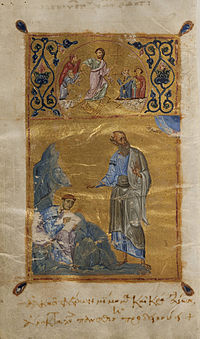Minuscule 1
|
New Testament manuscript |
|

Folio 265 verso, portrait of John and Prochor
|
|
| Name | Basiliensis A.N.IV.2 |
|---|---|
| Text | New Testament (except Apocalypse) |
| Date | 12th century |
| Script | Greek |
| Now at | Basel University Library |
| Cite | K. Lake, Codex 1 of the Gospels and its Allies, (Cambridge 1902) |
| Size | 18.5 cm by 11.5 cm |
| Type | Caesarean, Byzantine text-type |
| Category | III, V |
| Hand | elegantly written |
| Note | member of f1 |
Codex Basilensis A. N. IV. 2, Minuscule 1 (on the list of Gregory-Aland), δ 254 (in von Soden's numbering) and formerly designated by 1eap to distinguish it from minuscule 1rK (which previously used number 1) is a Greek minuscule manuscript of the New Testament, usually dated palaeographically to the 12th century AD. It is written on 297 parchment leaves and contains the entire New Testament except the Book of Revelation.
The codex was prepared for liturgical use with marginalia (text's division), and has almost completely survived; it was used by Erasmus for his Novum Instrumentum omne. The text of the manuscript has been cited in all critical editions of the Greek New Testament; in this codex, the text of the Gospels is more highly esteemed by scholars than that of the remaining New Testament books. The codex is housed at the Basel University Library, with shelf number A. N. IV, 2 (earlier B. VI. 27).
The codex contains the entire New Testament (except of Book of Revelation) in the following order: the Gospels, the Acts of the Apostles and the General and Pauline epistles (Hebrews is the last book in Paul). The text is written in one column per page, 38 lines per page, on 297 parchment leaves (18.5 cm by 11.5 cm). It was originally accompanied by miniatures, which were stolen before 1860–1862 (except one before the Gospel of John, which remains).
...
Wikipedia
